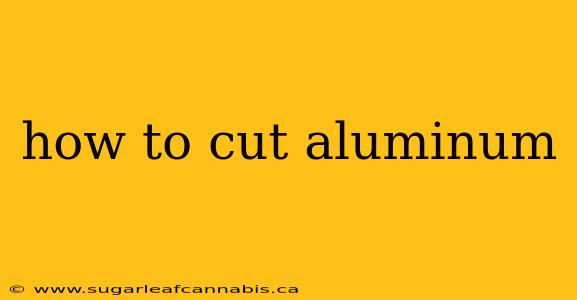Aluminum is a versatile metal used in countless applications, from construction and automotive parts to crafting and DIY projects. Knowing how to cut aluminum effectively and safely is a crucial skill. This guide explores various methods, their pros and cons, and safety precautions to ensure a successful cut every time.
Choosing the Right Cutting Method for Your Aluminum
The best method for cutting aluminum depends on several factors: the thickness of the aluminum, the desired cut quality (straight, curved, intricate), the tools available, and your budget.
1. Hand Sawing Aluminum
Pros: This is the most accessible method for thinner aluminum sheets, requiring minimal setup.
Cons: Slow, labor-intensive, and prone to producing uneven cuts, especially on thicker pieces.
How-to: Use a fine-toothed hacksaw blade specifically designed for metal. Apply consistent, even pressure, keeping the blade perpendicular to the surface. Lubricate the blade with cutting oil to reduce friction and extend blade life.
2. Jigsaws for Aluminum Cutting
Pros: Versatile for both straight and curved cuts, relatively inexpensive, and readily available.
Cons: Can be slower than other power tools, requires a specialized blade for aluminum (usually with a high tooth count).
How-to: Use a jigsaw with a fine-toothed blade designed for aluminum. Use a slow speed and avoid excessive pressure to prevent overheating the blade and warping the aluminum. A guide is beneficial for straighter cuts.
3. Reciprocating Saw (Sawzall) for Cutting Aluminum
Pros: Powerful, fast cutting, excellent for thicker aluminum and demolition work.
Cons: Can be less precise than other methods, generates significant noise and vibration. Appropriate safety gear is crucial.
How-to: Use a metal-cutting blade designed for aluminum. Work with a slow, controlled motion and focus on maintaining a steady hand. The metal-cutting blade's teeth are designed to easily cut the aluminum.
4. Circular Saw: Cutting Aluminum Efficiently
Pros: Very fast and efficient, particularly for straight cuts on thicker aluminum sheets.
Cons: Requires a specific blade designed for aluminum; careful setup is crucial to avoid binding and kickback.
How-to: Use a circular saw with a carbide-tipped blade designed for cutting non-ferrous metals, like aluminum. Secure the aluminum workpiece firmly. Make sure the blade is sharp and properly aligned for a clean cut.
5. Using a Rotary Tool (Dremel) for Aluminum Cutting
Pros: Excellent for intricate cuts and detailed work, ideal for smaller projects and hobbyists.
Cons: Slower cutting speed than power saws, requires precision and patience.
How-to: Use a cutting disc designed for aluminum. Work slowly and carefully to prevent the disc from overheating or breaking.
6. Shearing Aluminum
Pros: Creates very clean, straight cuts, ideal for large, flat sheets.
Cons: Requires specialized shearing equipment, not suitable for curved cuts or intricate shapes.
How-to: Sheet metal shears are usually powered and require safety practices including using the safety guards.
7. Plasma Cutting Aluminum
Pros: Extremely fast and precise cutting, suitable for thick aluminum sheets and complex shapes.
Cons: Requires specialized and expensive equipment, potential for harmful fumes and requires a well-ventilated workspace.
How-to: Plasma cutters use a high-temperature arc to melt and vaporize the aluminum. Always wear appropriate personal protective equipment (PPE).
8. Waterjet Cutting Aluminum
Pros: Extremely precise and clean cuts, can cut intricate shapes in thick aluminum, little to no heat-affected zone.
Cons: Requires specialized and expensive equipment.
How-to: Waterjet cutting uses high-pressure water mixed with an abrasive to cut the material. This is usually done by a professional.
Safety Precautions When Cutting Aluminum
Regardless of the chosen method, prioritize safety:
- Eye protection: Always wear safety glasses or a face shield. Flying debris is a common hazard.
- Hearing protection: Power tools generate significant noise; use earplugs or earmuffs.
- Respiratory protection: Some cutting methods produce fumes or dust; a respirator might be necessary, especially with plasma cutting.
- Gloves: Wear work gloves to protect your hands from sharp edges and potential cuts.
- Proper ventilation: Ensure adequate ventilation to remove fumes and dust.
- Secure workpiece: Clamp the aluminum securely to prevent movement during cutting.
- Sharp blades: Use sharp blades or cutting tools. Dull tools require more force, increasing the risk of injury or damage.
Conclusion: Mastering Aluminum Cutting
Cutting aluminum successfully involves choosing the right method based on your needs and using proper safety measures. Whether you're a seasoned professional or a DIY enthusiast, understanding these techniques will allow you to safely and effectively tackle your aluminum cutting projects. Remember to always prioritize safety above all else.
